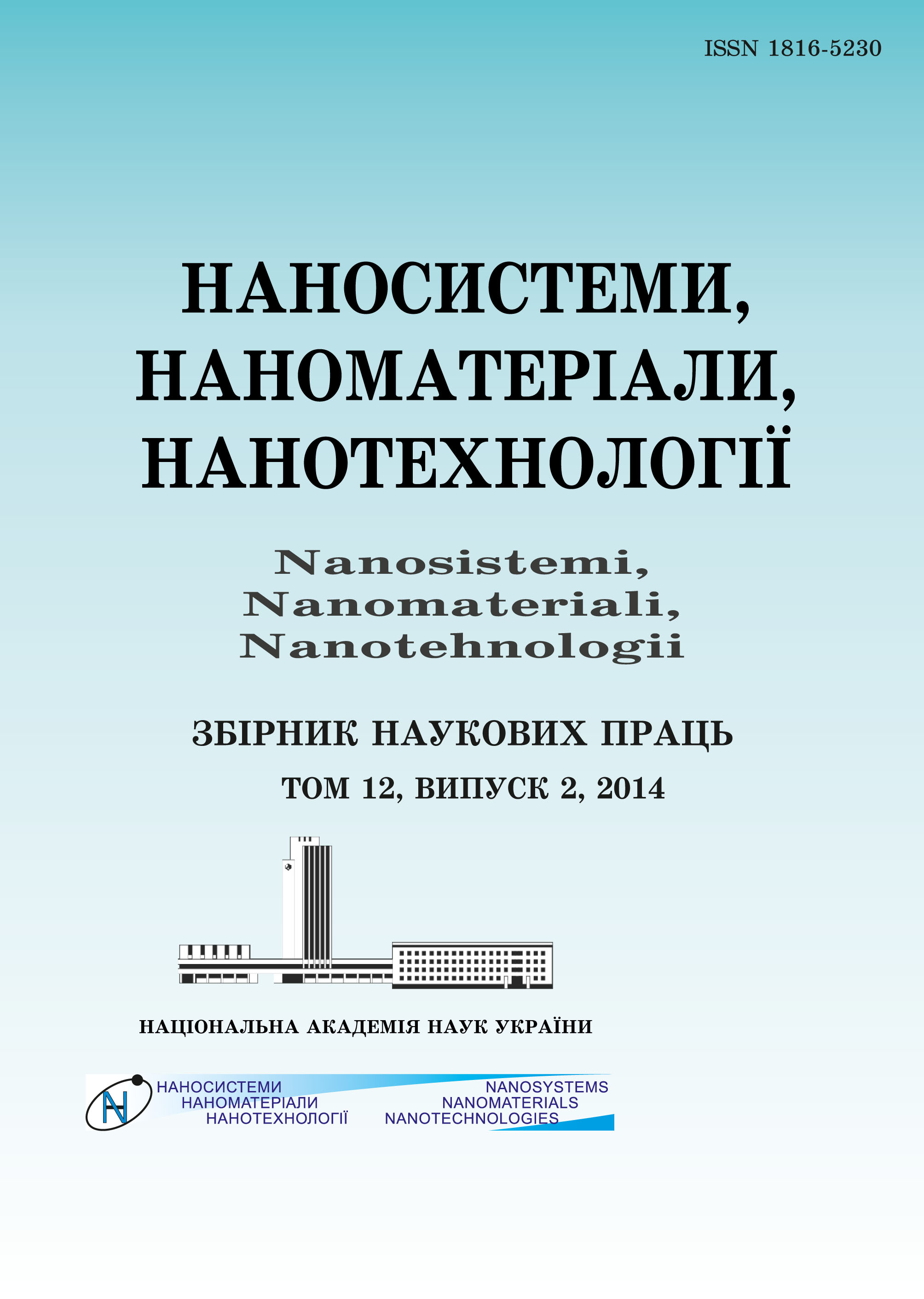|
|
|||||||||

|
Year 2024 Volume 22, Issue 1 |
|
|||||||
|
|||||||||
Issues/2024/vol. 22 /issue 1 |
|
K.O. KUDELKO, O.H. DZIAZ'KO, L.M. ROZHDESTVENS'KA, L.B. KHAR'KOVA,
and V.M. OGENKO
Formation of Nanopores in Anodic Oxidized
Aluminium under the Influence of Carbon Nanoparticles
53–65 (2024)
PACS numbers: 61.43.Gt, 78.30.Na, 78.40.Ri, 81.05.Je, 81.05.Rm, 82.47.Wx, 82.80.Gk
The conditions and characteristics for nanoporous anodic oxidized aluminium (AOA) are presented. The anodizing process is carried out in a solution of oxalic acid containing carbon nanoparticles (CNPs). The carbon nanoparticles are studied by ultraviolet–visible spectroscopy, dynamic laser scattering (in the aggregated state), Raman spectroscopy, and infrared spectroscopy. Scanning electron microscopes are used to study the morphology of the AOA. The pore size of the porous layer is of 20–40 nm, and the pore-wall thickness is up to 50 nm. In the absence of the addition of carbon material, similar surface parameters are of 50–100 nm and 30 nm, respectively. The effect of the carbon material on the structuring of the pore layer is explained in terms of adsorption of it on the AOA during anodizing process. A high-disordered structure of carbon nanoparticles is revealed. The adsorption isotherm is obtained, and it is found that the Temkin model is the most suitable for describing the sorption equilibrium. The crystallization of AOA under hydrothermal conditions at 200C is proposed. The addition of CNDs to the oxalic acid electrolyte reduces the pore size of obtained anodized aluminium. Carbon nanoparticles effect on the formation of the porous structure of AOA with adsorption. The advantage of CNDs over GO is the fabrication of AOA with smaller pores in mild conditions without aggressive reagents. The effect of CNDs on the porous structure of AOA can be explained, on the one hand, by its shielding by carbon nanoparticles, and on the other hand, by the "damping effect" of CNDs on the faster thermal expansion of aluminium compared to Al2O3. It is possible to obtain samples of AOA with nanoscale pores by environmentally friendly synthesis using cheap and readily available chemicals. To obtain crystalline Al2O3, hydrothermal treatment can be implemented that has the advantage of a lower crystallization temperature over calcination.
KEY WORDS: anodic oxidized aluminium, carbon nanoparticles, nanopores, adsorption, anodizing mechanism
DOI: https://doi.org/10.15407/nnn.22.01.053
REFERENCES
- K. A. Evans, Properties and Uses of Aluminium Oxides and Aluminium Hydroxides (Ed. A. J. Downs) (London–New York: Pergamon Press: 1993), p. 993.
- H. K. Hami, R. F. Abbas, E. M. Eltayef, and N. I. Mahdi, Samarra J. Pure Appl. Sci., 2: 19 (2020); https://doi.org/10.54153/sjpas.2020.v2i2.109
- M. Pica, Molecules, 26: 2392 (2021); https://doi.org/10.3390/molecules26082392
- Y. S. Dzyazko, L. M. Rozhdestvenska, and A. V. Palchik, Sep. Pur. Techn., 45: 141 (2005).
- A. V. Pal’chik, Yu. S. Dzyaz’ko, and L. M. Rozhdestvenskaya, Russ. J. Appl. Chem., 75: 414 (2005).
- T. V. Maltseva, E. O. Kudelko, and V. N. Belyakov, Russ. J. Phys. Chem. A, 83: 2336 (2009).
- T. V. Mal’tseva, T. V. Yatsenko, E. O. Kudelko, and V. N. Belyakov, Russ J. Appl. Chem., 84: 756 (2011).
- T. V. Mal’tseva, A. V. Pal’chik, E. O. Kudelko, S. L. Vasilyuk, and K. A. Kazdobin, J. Water Chem. Techn., 37: 18 (2015); https://doi.org/10.3103/S1063455X15010051
- X.-M. Wang, X.-Y. Li, and K. Shih, J. Membr. Sci., 368: 134 (2011); https://doi.org/10.1016/j.memsci.2010.11.038
- T. A. Saleh and V. K. Gupta, Sep. Purif. Tech., 89: 245 (2012); doi:10.1016/j.seppur.2012.01.039
- M. Branchi, M. Sgambetterra, I. Pettiti, S. Panero, and M. A. Navarra, Inter. J. Hydr. Ener., 40: 14757 (2015); doi:10.1016/j.ijhydene.2015.07.030
- V. Myronchuk, Yu. Zmievskii, Yu. Dzyazko, L. Rozhdestvenska, and V. Zakharov, Acta Periodica Techn., 49: 103 (2018); https://doi.org/10.2298/APT1849103M
- Yuliya Dzyazko, Liudmyla Rozhdestveskaya, Yurii Zmievskii, Yurii Volfkovich, Valentin Sosenkin, Nadejda Nikolskaya, Sergey Vasilyuk, Valerii Myronchuk, and Vladimir Belyakov, Mater. Today: Proceed., 2: 3864 (2015); doi:10.1016/j.matpr.2015.08.003
- V. G. Myronchuk, Y. S. Dzyazko, Yu. G. Zmievskii, A. I. Ukrainets, A. V. Bildukevich, L. V. Kornienko, L. M. Rozhdestvenskaya, and A. V. Palchik, Acta Periodica Techn., 47: 153 (2016); https://doi.org/10.2298/APT1647153M
- Y. S. Dzyazko, L. M. Rozhdestvenska, S. L. Vasilyuk, K. O. Kudelko, and V. N. Belyakov, Nanoscale Res. Let., 12: 1 (2017); doi:10.1186/s11671-017-2208-4
- S. Szabolcs, V. Feh?r, D. Kurhan, A. N?meth, M. Sysyn, and S. Fischer, Infrastructures, 8: 1 (2023); https://doi.org/10.3390/infrastructures8020027
- L. Rozhdestvenska, K. Kudelko, V. Ogenko, and M. Chang, Ukr. Chem. J., 86: 67 (2021); https://doi.org/10.33609/2708-129X.86.12.2020.67-102
- R. Kavian, A. Vicenzo, and M. Bestetti, J. Mater. Sci., 46: 1487 (2011); doi:10.1007/s10853-010-4950-1
- L. Zaraska, E. Kurowska, G. D. Sulka, I. Senyk, and M. Jaskula, J. Solid State Electrochem., 18: 36 (2014); https://doi.org/10.1007/s10008-013-2215-z
- G. Yongji, X. Mingyang, and Z. Jinlong, Appl. Surf Sci., 319: 8 (2014); doi:10.1016/j.apsusc.2014.04.182
- K. Kudelko, L. Rozhdestvenskaya, V. Ogenko, and V. Chmilenko, Appl. Nanosci., 12: 1967 (2022); https://doi.org/10.1007/s13204-022-02457-y
- V. Ogenko, S. Orysyk, L. Kharkova, O. Yanko, and D. Chen, Ukr. Chem. J., 87: 3 (2021); https://doi.org/10.33609/2708-129X.87.09.2021.3-13
- A. Perrotta, Mat. Res. Innovat., 2: 33 (1998); https://doi.org/10.1007/s100190050058
- J. Schneider, C. J. Reckmeier, Y. Xiong, M. von Seckendorff, A. S. Susha, P. Kas?k, and A. L. Rogac, J. Phys. Chem. C, 121: 2014 (2017); doi:10.1021/ACS.JPCC.6B12519
- Kazuo Nakamoto, Infrared and Raman Spectra of Inorganic and Coordination Compounds (USA: John Wiley & Sons, Inc., Publication: 1997); https://download.e-bookshelf.de/download/0000/5722/69/L-G-0000572269-0002357953.pdf
- I. Childres, L. A. Jauregui, W. Park, H. Cao, and Y. P. Chen, Raman Spectroscopy of Graphene and Related Materials. In: New Developments in Photon and Materials Research (Ed. J. I. Jang) (Nova Science: 2013), pp. 1–20.
 This article is licensed under the Creative Commons Attribution-NoDerivatives 4.0 International License ©2003—2024 NANOSISTEMI, NANOMATERIALI, NANOTEHNOLOGII G. V. Kurdyumov Institute for Metal Physics of the National Academy of Sciences of Ukraine. E-mail: tatar@imp.kiev.ua Phones and address of the editorial office About the collection User agreement |